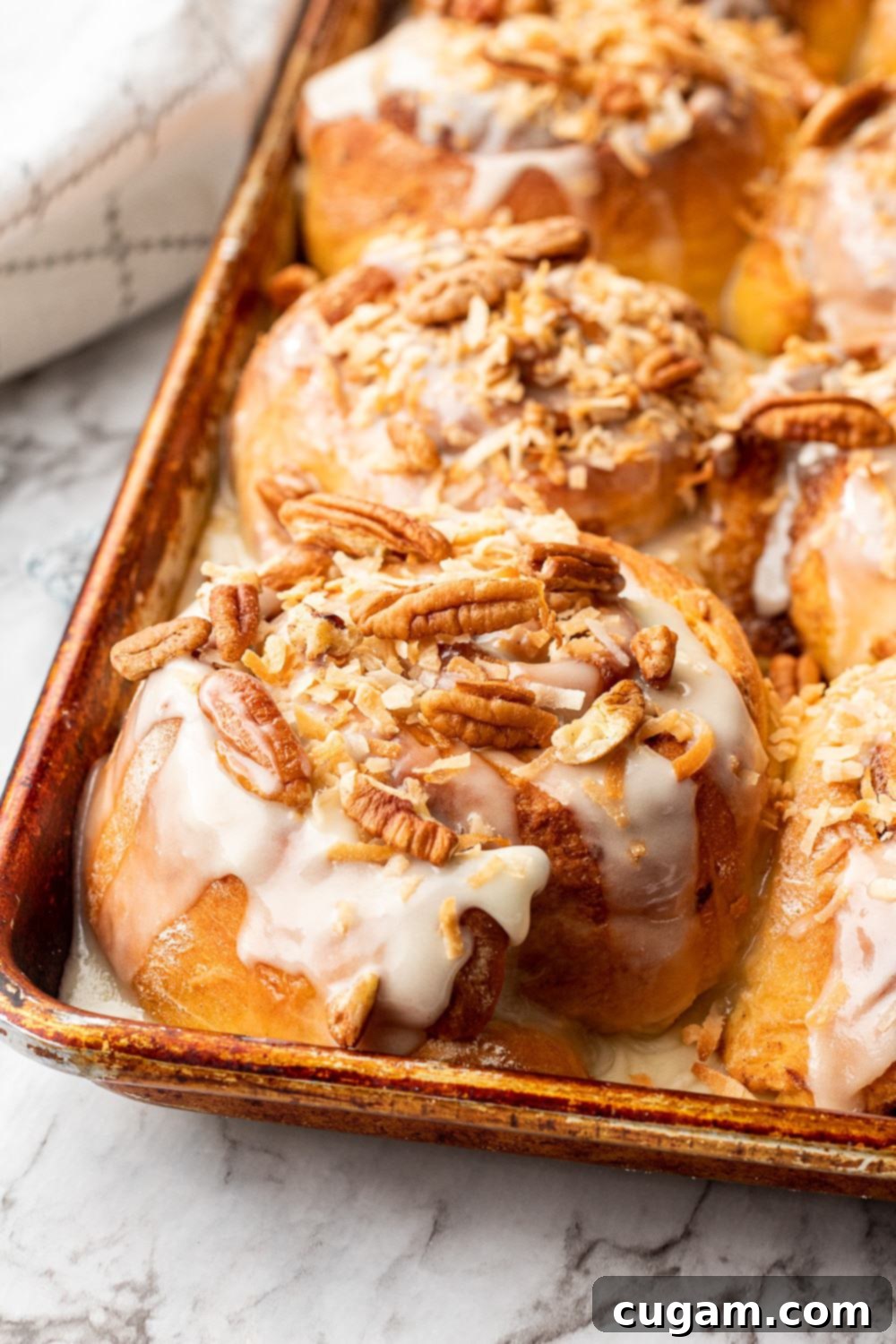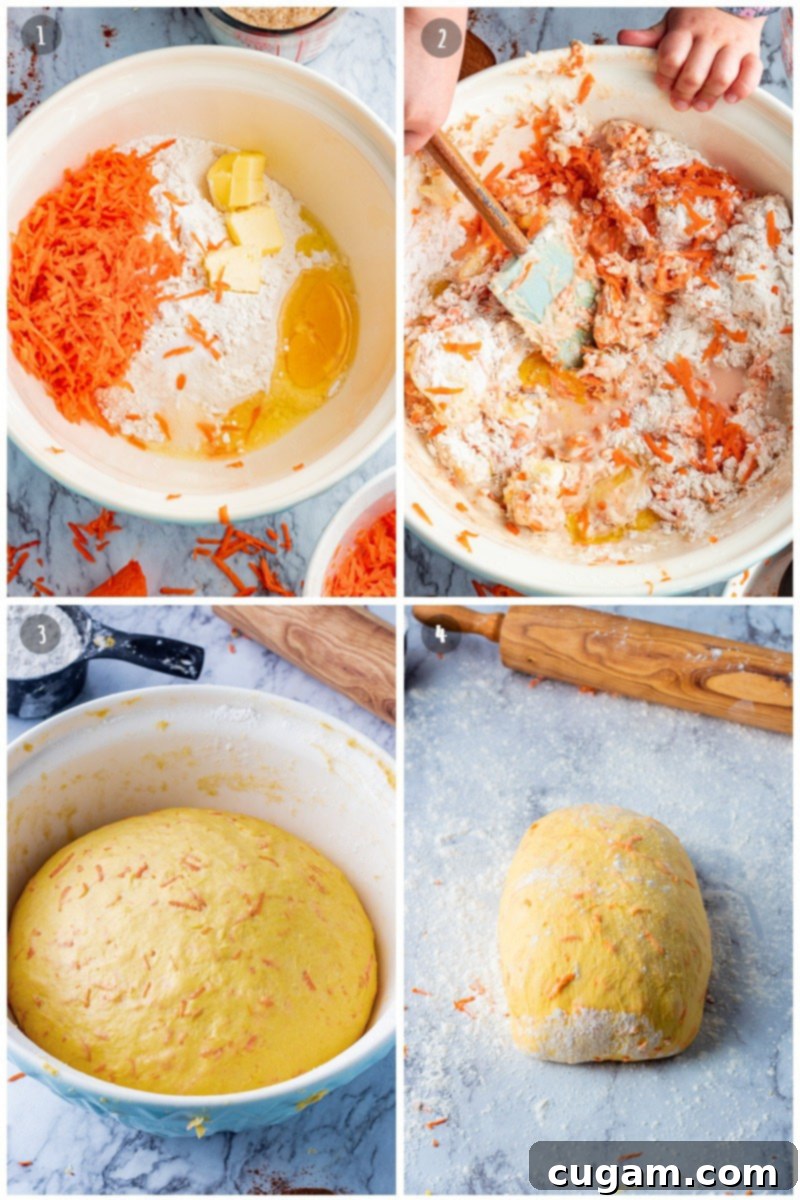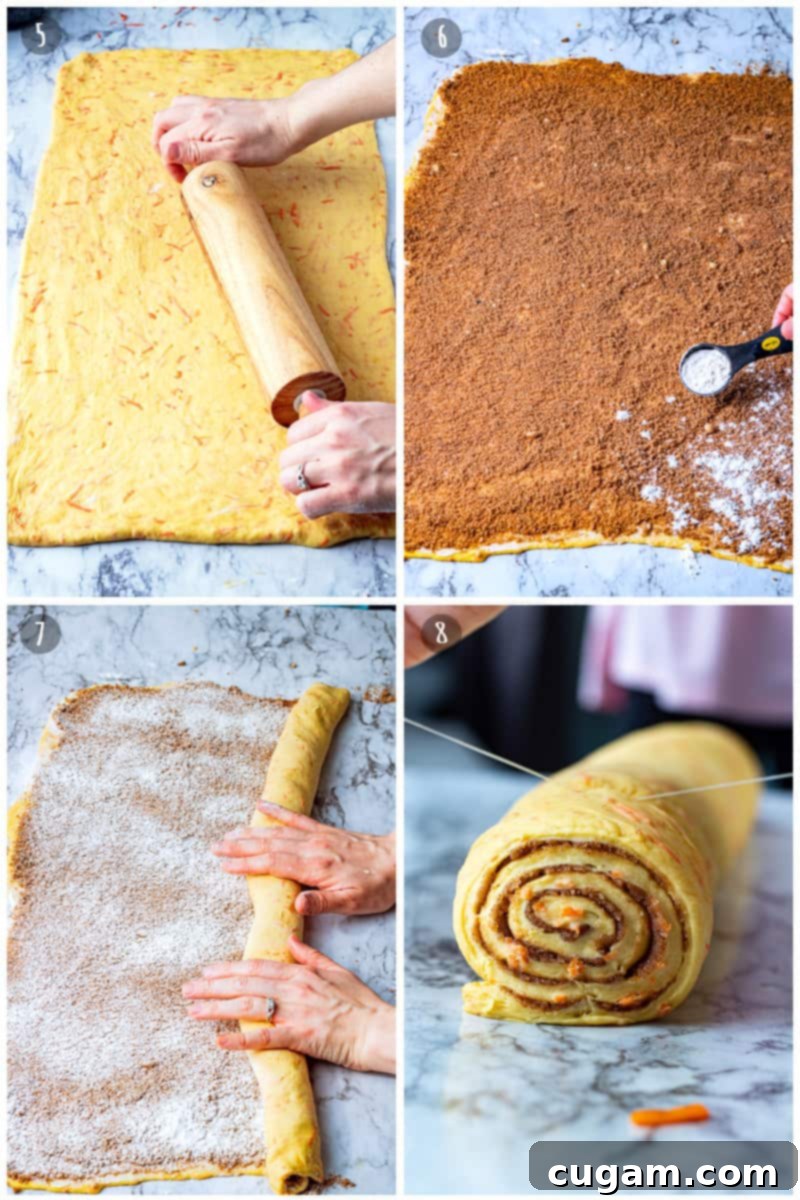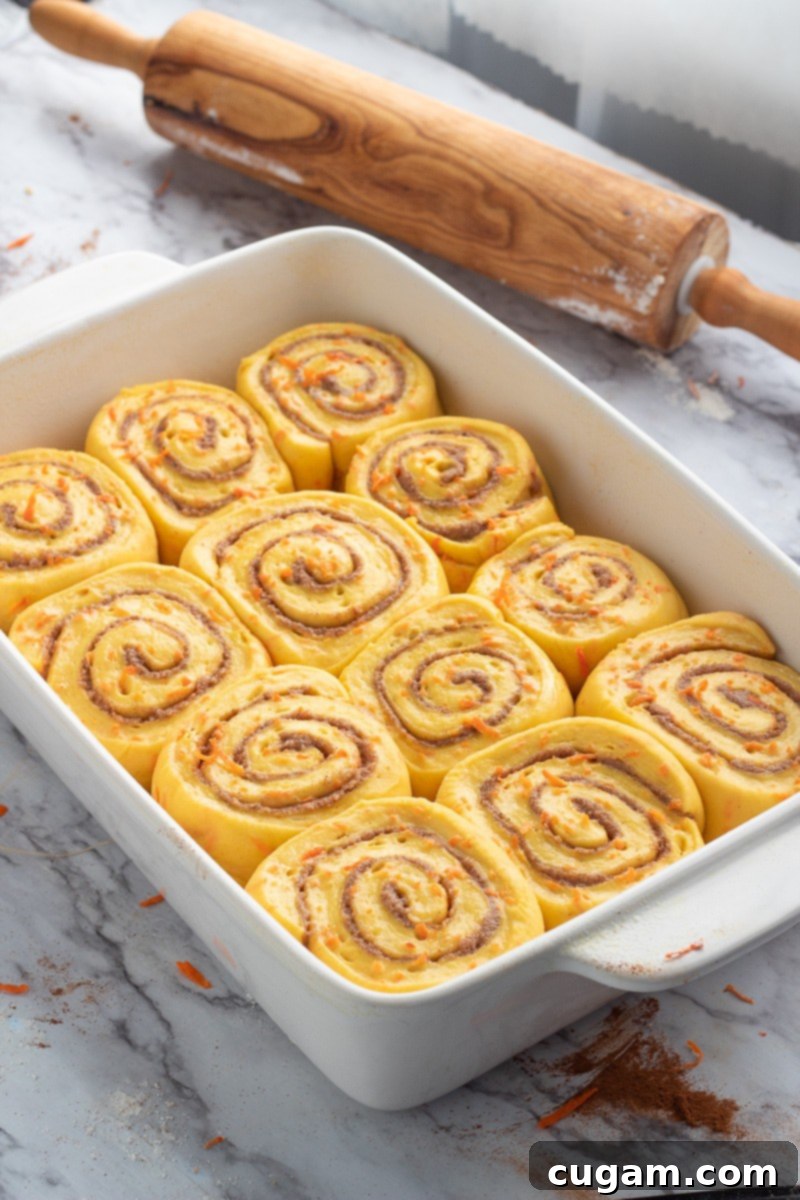Decadent Carrot Cake Cinnamon Rolls from Scratch: Your New Favorite Holiday Treat
Prepare yourself for a truly extraordinary treat: these Homemade Carrot Cake Cinnamon Rolls. Imagine the cozy, spiced comfort of a classic carrot cake fused with the irresistible swirl of a warm cinnamon roll, all generously topped with a rich, tangy cream cheese frosting. This isn’t just a dessert; it’s an experience, especially perfect for brightening up your Easter brunch or any special holiday breakfast gathering. Packed with tender grated carrots, crunchy pecans, and a hint of sweet coconut, these rolls are a celebration of flavor and texture, made entirely from scratch.
Whether you know them as cinnamon rolls, sweet buns, or Chelsea buns, there’s no denying their universal appeal. They are a staple in many households, especially during festive seasons. While I adore traditional variations like my Best Homemade Orange Rolls and comforting Pumpkin Cinnamon Rolls – both fantastic choices for a holiday spread – this carrot cake rendition takes the beloved classic to an entirely new level. It combines the best of both worlds, creating a uniquely delicious hybrid that is surprisingly easy to master at home. And if you enjoy other carrot-infused delights, you might also love my Carrot Banana Muffins.
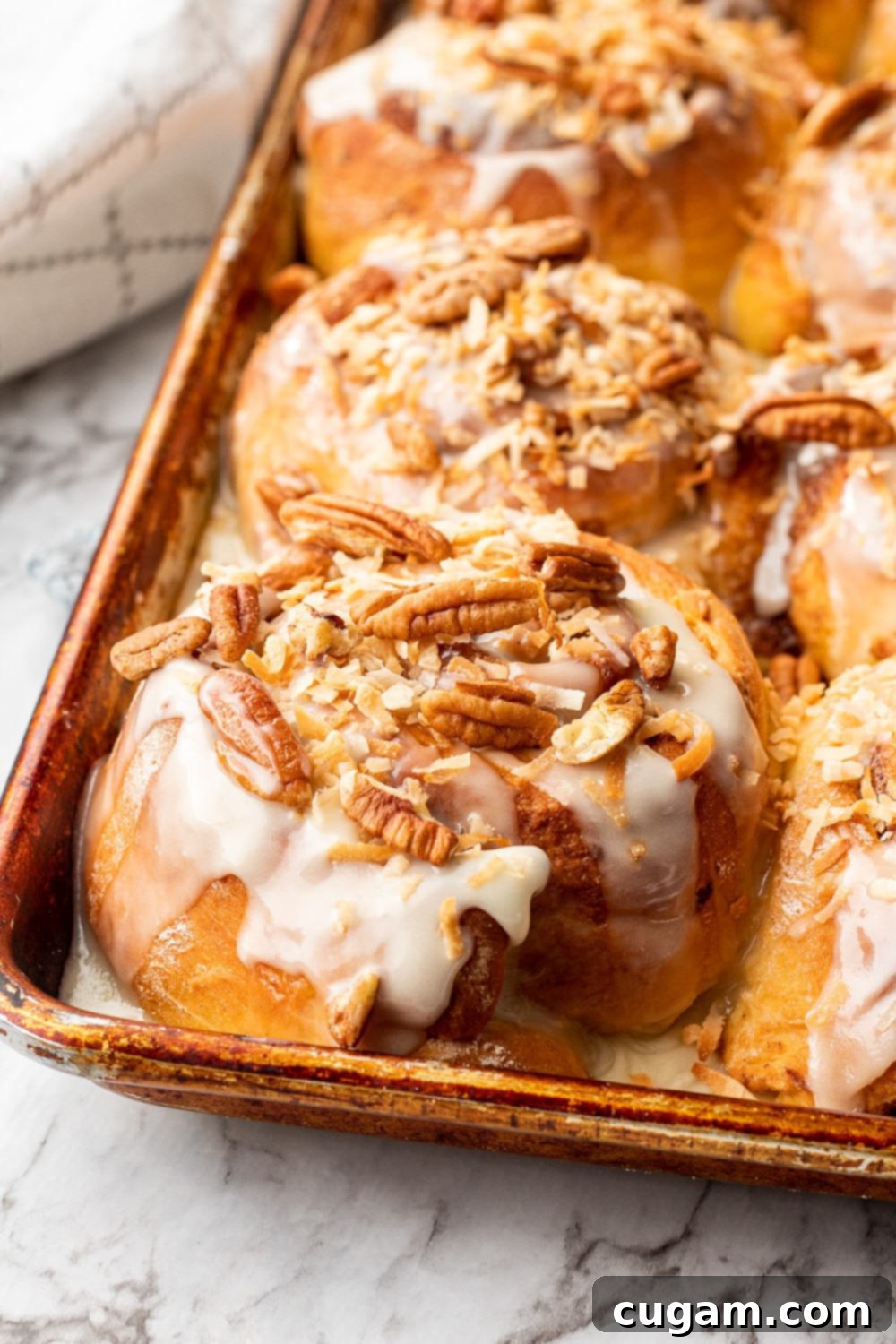
The idea of combining the lusciousness of carrot cake with the soft, sweet spirals of cinnamon rolls was a stroke of genius, and the result is truly a match made in heaven. My own little bakers (my kids!) were invaluable in testing this recipe multiple times, ensuring every detail was perfect. We collectively agree: these are a new family favorite. This comprehensive guide will walk you through every step, from mastering the fluffy carrot-infused dough to preparing the aromatic cinnamon filling, and finally, crafting that luscious cream cheese frosting. You’ll also find invaluable tips for making the process smooth and enjoyable, guaranteeing bakery-quality carrot cake cinnamon rolls right in your own kitchen.
Step-by-Step Instructions for Your Perfect Carrot Cake Cinnamon Rolls
-
Activate the Yeast and Prepare the Dough Base: Begin by combining warm milk (ensure it’s between 100-110°F/38-43°C – too hot will kill the yeast, too cold won’t activate it), granulated sugar, and active dry yeast in a small bowl. Let this mixture sit for about 5 minutes until it becomes visibly foamy. This foaminess is your confirmation that the yeast is active and ready to work its magic. While the yeast is activating, gather your other dough ingredients in a large mixing bowl or the bowl of your stand mixer: grated carrots, softened butter, a large egg, salt, and 5 cups of all-purpose flour. The vibrant grated carrots are key to infusing that authentic carrot cake flavor and moisture directly into the dough.
-
Combine Ingredients and Knead the Dough: Once your yeast mixture is foamy, pour it into the large bowl with the other assembled dough ingredients. If using a stand mixer, attach the dough hook and mix on low speed for 5-8 minutes. Continue mixing until the dough forms a ball and becomes smooth and elastic. Elasticity is crucial for soft, chewy rolls; it means the gluten has developed properly. If you’re kneading by hand, mix with a sturdy wooden spoon until the dough becomes too stiff to stir, then turn it out onto a lightly floured surface and knead for 6-8 minutes. This dough tends to be slightly sticky, which contributes to its tenderness. If you find it too challenging to handle by hand, a light spray of cooking oil on your hands can make the process much easier, or simply rely on your stand mixer’s dough hook. Gradually add the remaining ½ cup (or up to one full cup, if necessary) of flour until the dough achieves a thick, manageable, yet still slightly tacky consistency.

-
First Rise for Fluffy Dough: Gently shape the kneaded dough into a smooth ball. Lightly oil a large bowl, place the dough ball inside, and turn it once to coat lightly with oil. Cover the bowl tightly with plastic wrap or a clean kitchen towel. Allow the dough to rise in a warm, draft-free spot at room temperature (ideally around 70-74°F or 21-23°C) for approximately 60 minutes, or until it has visibly doubled in size. This initial rise is essential for developing flavor and creating that light, airy texture characteristic of perfect cinnamon rolls.
-
Prepare the Dough for Filling: Once the dough has completed its first rise, gently deflate it by pressing down lightly. Turn the dough out onto a lightly floured work surface. Carefully shape it into a loose rectangle or log. Avoid overworking the dough at this stage, as excessive kneading after the first rise can make it less pliable and stretchy, impacting the final texture of your rolls.
-
Roll Out the Dough Evenly: Using a rolling pin, roll the dough into a large rectangle, aiming for dimensions of about 24 inches long by 14-16 inches wide. As you roll, periodically adjust the edges with your hands to keep the corners as square as possible. This meticulous shaping now will ensure that your finished cinnamon rolls are uniform in size and appearance, giving them that coveted bakery-quality look.
-
Spread the Filling: Generously spread the softened butter evenly over the entire surface of the rolled-out dough rectangle. This butter layer is the foundation for your delicious filling. Next, liberally sprinkle your brown sugar and spice mixture (a blend of cinnamon, ginger, clove, and nutmeg for that true carrot cake essence) over the butter. Finally, and this is a crucial pro tip, evenly sprinkle 4-5 tablespoons of all-purpose flour over the entire filling. This flour acts as a binding agent, helping to absorb excess moisture and prevent the filling from melting out and crystallizing at the bottom of the pan during baking, ensuring a perfectly gooey center for every roll.

-
Roll and Seal: Carefully and gently roll the dough lengthwise into a tight, long log. Take your time to ensure the filling stays securely inside the roll. Once rolled, make sure the seam side is placed down to help prevent it from unraveling during the second rise and baking.
-
Slice the Rolls: For perfectly clean and uniform slices, use a piece of plain, unflavored dental floss or a thin, strong string. Slide the string underneath the rolled dough log. Cross the ends of the string over the top and pull them tight to slice through the dough. This method creates much cleaner cuts than a knife, preserving the beautiful spiral shape. Aim for 12 equal slices, each approximately 2 inches wide. I often make light marks with the string before cutting to guide myself and ensure consistent sizes. If you prefer, a very sharp, un-serrated knife can also be used with a gentle, sawing motion.

-
Second Rise and Preheat: Arrange the sliced carrot cake cinnamon rolls, cut-side down, in a lightly greased 9×13 inch baking pan or on an 11×18 inch baking sheet. Ensure there’s a little space between each roll, as they will expand significantly. Cover the pan loosely with plastic wrap or a clean kitchen towel and let them rise again in a warm place for 45-60 minutes, or until they are almost doubled in size and look visibly puffy. Towards the end of the rising time, preheat your oven to 350°F (175°C).
-
Bake to Golden Perfection: Bake the rolls in your preheated oven. If using a 9×13 inch glass pan, they will typically need 32-35 minutes. Keep an eye on them; if the tops start to brown too quickly, you might want to loosely tent the pan with foil for the last 10 minutes of baking. If you’re baking on an 11×18 inch baking sheet, they will generally bake faster, requiring around 25 minutes, achieving beautiful bakery-style results with slightly crispier edges. The rolls should be golden brown and cooked through.
-
Prepare and Frost: While the rolls are cooling slightly (about 15-20 minutes, allowing them to set but still be warm), prepare your luscious cream cheese frosting. In a medium bowl, combine softened cream cheese, softened butter, vanilla extract, powdered sugar, and 2-3 tablespoons of whole milk or heavy cream. Mix until the frosting is completely smooth and free of lumps. If needed, you can microwave the cream cheese and butter for 10-20 seconds to help them soften sufficiently for mixing. For a thicker, more traditional frosting consistency, use less milk; for a thinner, more glaze-like topping, add an extra tablespoon or two of milk or cream. Generously spoon the smooth frosting over the still-warm baked cinnamon rolls, ensuring an even coating. For an extra touch of flavor and texture, scatter toasted coconut and chopped pecans over the top. Serve these delectable carrot cake cinnamon rolls warm for an unforgettable experience!
Cream Cheese Frosting: The Essential Topping
No cinnamon roll, especially a carrot cake one, is complete without a generous slathering of decadent cream cheese frosting. This rich and tangy topping perfectly complements the sweet and spiced rolls, adding a layer of creamy indulgence that makes every bite heavenly. While my go-to is a classic cream cheese icing, I sometimes enjoy experimenting by substituting mascarpone cheese for cream cheese. Mascarpone offers a slightly sweeter, richer, and even more luxurious texture, providing a subtle variation that connoisseurs will appreciate.
The recipe provided yields a frosting that is more akin to a thick, spreadable frosting than a thin glaze. This allows for a substantial, delightful topping on each roll. However, if you prefer a lighter, more pourable glaze consistency, you can easily customize it. Simply add an extra tablespoon or two of whole milk or heavy cream to the mixture until you achieve your desired thickness. Remember, the key is to adjust gradually, mixing well after each addition, to ensure you don’t make it too thin. This versatility means you can tailor the frosting to your personal preference, making these carrot cake cinnamon rolls truly your own.
Make-Ahead Magic: Overnight Instructions for Convenience
For those special mornings when you want freshly baked carrot cake cinnamon rolls without the early start, this recipe is perfectly adaptable for overnight preparation. Prepping them the night before allows the dough to slowly develop flavor in the refrigerator and saves you significant time on the day you plan to serve them.
-
Prepare and Arrange Rolls: Follow the main recipe instructions exactly through making the dough, adding the delicious carrot cake filling, rolling, and carefully cutting the dough into 12 equal rolls. Place these unbaked rolls, cut-side down, into your prepared 9×13 inch baking pan or on a large baking sheet, ensuring they are not too crowded.
-
Crucial Step: Do Not Rise First: This is a critical point for overnight rolls. Once the rolls are placed in the pan, cover them tightly with plastic wrap. It is essential that you do not allow the dough to complete its first rise before refrigerating. If the dough rises fully before being chilled, the delicate structure can collapse, causing the rolls to deflate and become dense in the refrigerator. The cold temperature of the fridge effectively slows down the yeast’s activity, putting it into a dormant state rather than killing it, allowing for a slow, flavorful fermentation overnight.
-
Chill Overnight: Place the covered pan of rolls into the refrigerator and let them chill overnight, for at least 8 hours and up to 16 hours. This slow, cold proofing contributes to a deeper, more complex flavor in the final product.
-
Morning Rise and Bake: The next morning, remove the pan of rolls from the refrigerator. Allow them to come to room temperature and complete their final rise in a warm spot for about 30-40 minutes. For an ideal warm environment, I like a “quick proof” trick: turn your oven on to 200°F (95°C) for just 2 minutes, then immediately turn it off. Place the rolls inside with the oven door slightly ajar. This creates a cozy, warm (but not hot) space for them to proof beautifully.
-
Baking the Next Day: Once the rolls have nearly doubled in size, preheat your oven to 350°F (175°C). Bake for 30-35 minutes if using a glass pan, or approximately 25 minutes if baking on a large, dark baking sheet. Remember that glass pans tend to require a few extra minutes of baking time compared to darker metal pans. Monitor for a beautiful golden-brown color. Once baked, let them cool slightly before frosting and enjoying your effortlessly fresh homemade carrot cake cinnamon rolls!
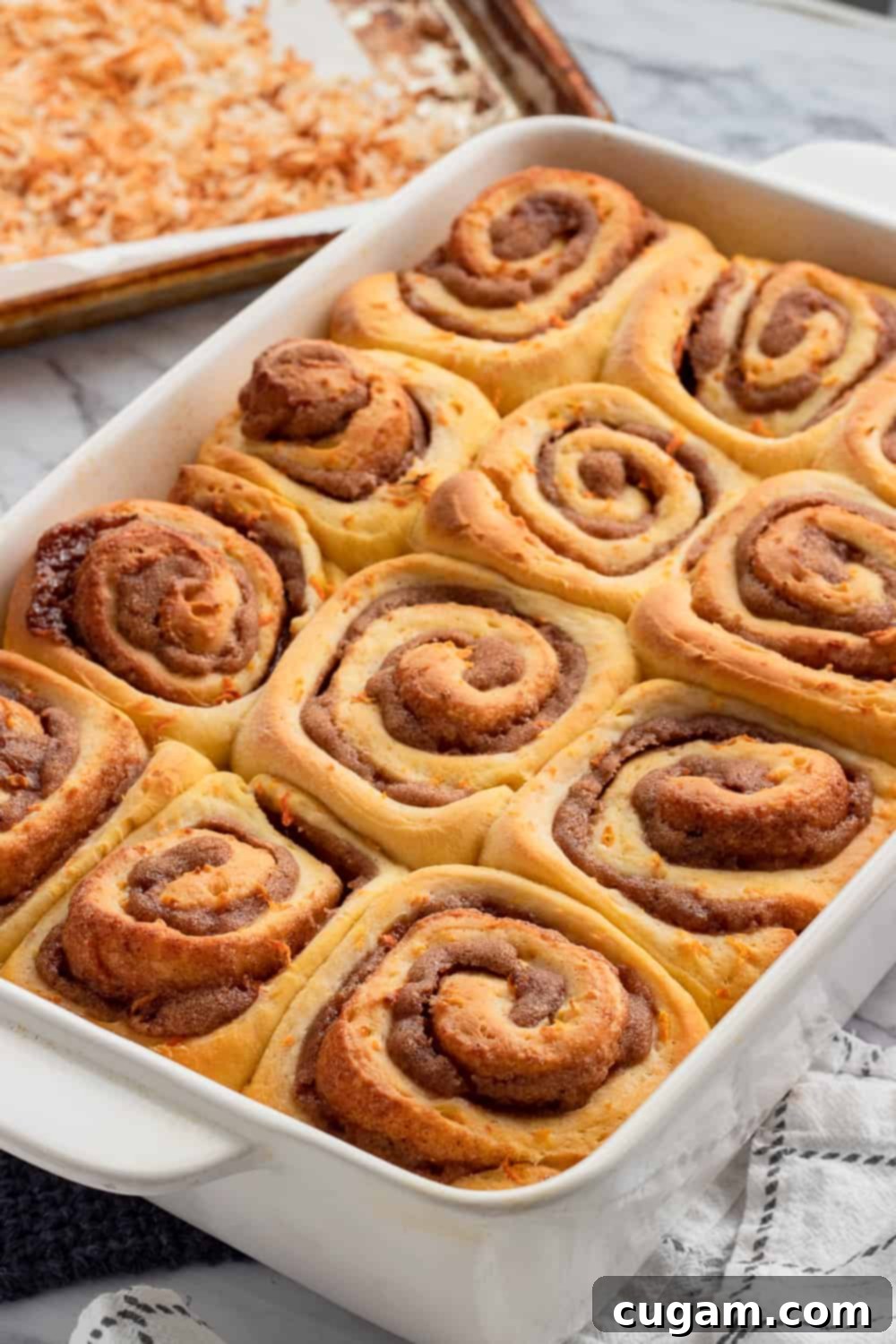
Freezer-Friendly Option: Enjoy Rolls Anytime
These delightful carrot cake cinnamon rolls are also perfect for freezing, allowing you to enjoy a freshly baked treat whenever a craving strikes, up to three months later. This is an excellent method for meal prepping or ensuring you always have a special breakfast on hand.
-
Prepare for Freezing: Follow the main recipe steps to prepare the dough, add the filling, roll, and cut the dough into individual rolls. Place these uncooked rolls into a foil-lined baking pan, ensuring the edges are not touching. Cover the pan securely with plastic wrap. It is crucial to place the rolls into the freezer immediately after cutting; do not let them rise first. Just like with the overnight method, if the dough rises before freezing, the yeast structure can be damaged, leading to deflated and dense rolls once thawed and baked. Once the rolls are completely frozen solid, you can transfer them to a freezer-safe bag or an airtight container to save space.
-
Storage Time: Store the frozen rolls for up to 3 months. When you’re ready to bake, remember this vital tip: Do NOT microwave the dough to thaw it. The microwave’s heat will instantly kill the yeast, preventing your rolls from rising properly.
-
Thawing and Rising (Regular Method): For a classic, slow thaw and rise, remove the frozen rolls from the freezer and place them, still covered, in a warm spot. Allow them to thaw and rise for 3-5 hours, or until they have nearly doubled in size. This method mimics a traditional proofing process.
-
Thawing and Rising (Quicker Method): If you’re short on time, use this accelerated rising technique: turn your oven to 200°F (95°C) for just 2 minutes, then switch it off. Place the frozen rolls inside the warm, turned-off oven and let them thaw and rise for 2-3 hours. This creates a consistent, gentle warmth that speeds up the yeast activation without damaging it.
-
Baking Frozen Rolls: Once the rolls have risen, preheat your oven to 350°F (175°C). Bake for approximately 25 minutes if using a large baking sheet, or 32-35 minutes if baking in a 9×13 inch pan. As always, glass pans may require a few extra minutes of baking compared to dark metal pans. Look for a beautiful golden-brown finish. Frost and serve warm for a delightful homemade treat anytime!
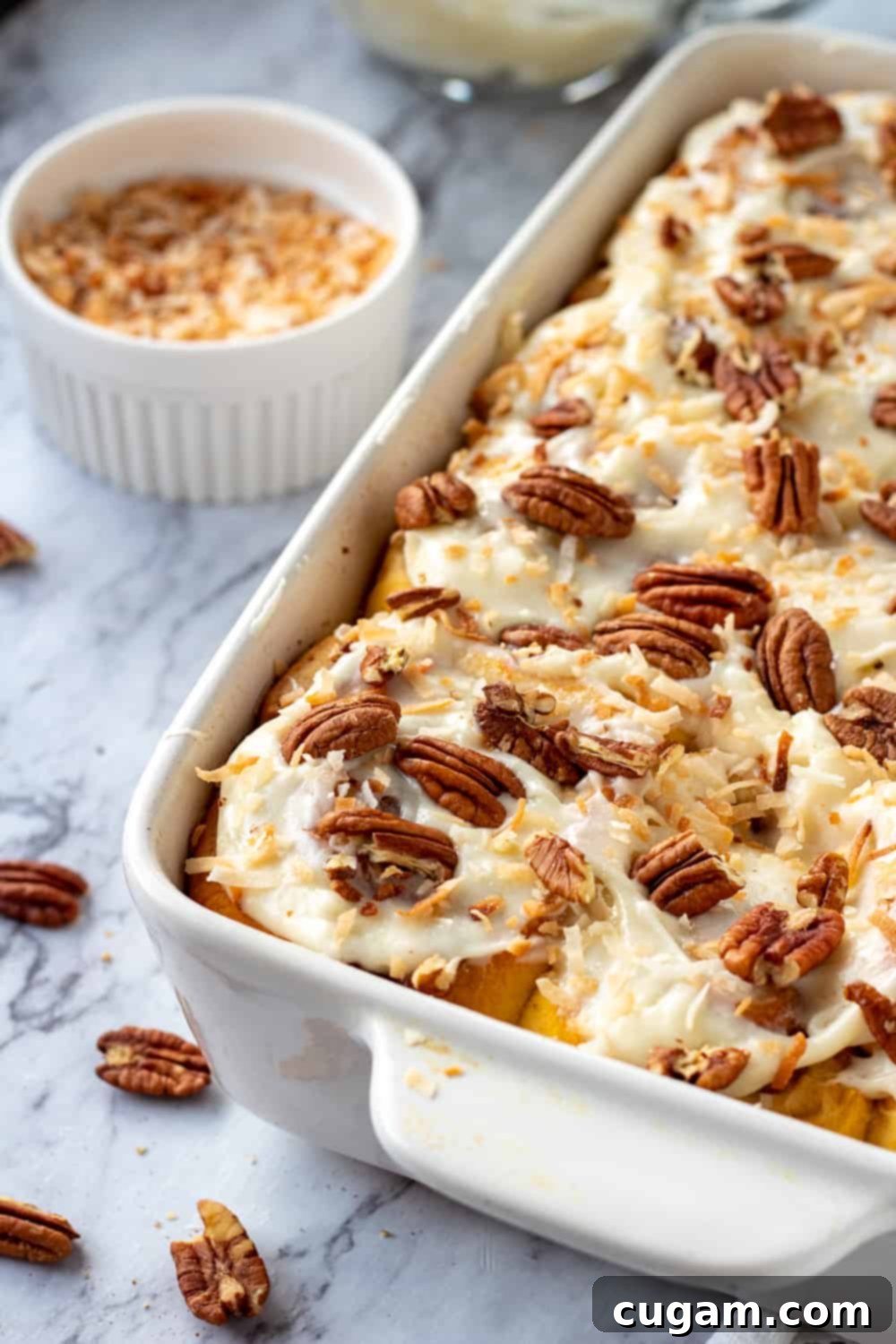
Expert Tips for Bakery-Perfect Carrot Cake Cinnamon Rolls
Achieving perfectly fluffy, gooey, and beautifully shaped carrot cake cinnamon rolls is easier than you think with these expert tips:
-
The Magic of Flour in the Filling: Don’t skip the step of sprinkling 4-5 tablespoons of all-purpose flour over your butter and cinnamon-sugar filling. This seemingly small detail makes a huge difference! The flour helps to absorb any moisture released from the butter and sugar during baking, preventing the filling from oozing out and turning into a hard, caramelized syrup at the bottom of your pan. Instead, it ensures your filling remains wonderfully gooey and perfectly contained within each roll, contributing to that irresistible sticky-sweet center we all love.
-
Precision Rolling for Uniform Rolls: When rolling out your dough, make an effort to keep the edges straight and the corners as square as possible. Take breaks during rolling to gently shape the dough with your hands. This attention to detail in the initial rectangular shape of the dough directly impacts the uniformity of your finished rolls. Straight edges mean consistent spirals, resulting in rolls that are all similar in size and shape once sliced, creating a more appealing presentation worthy of a professional bakery.
-
Choosing Your Baking Vessel: The pan you choose can influence the final texture and appearance of your rolls:
- For spectacular, individual bakery-style cinnamon rolls with slightly crispier exteriors, ideal for a bake sale or impressing guests, opt for an 11×18 inch baking sheet. Spacing them out allows for more even browning.
- For a more traditional, “pull-apart” family-style breakfast, where the rolls bake closely together and stay extra moist and soft, use a 9×13 inch baking pan. This size is also perfect for preparing the rolls using the overnight rise method.
-
Enhance Flavor with Toasted Coconut: While optional, adding toasted coconut to the top of your frosted carrot cake cinnamon rolls elevates their flavor and texture considerably. The toasting process brings out a nutty, deeper coconut flavor and adds a delightful crunch that contrasts beautifully with the soft rolls and creamy frosting.
- To toast coconut: Preheat your oven to 350°F (175°C). Line a baking sheet with parchment paper and spread 1 cup of shredded coconut (sweetened or unsweetened works) evenly in a single layer. Bake for 5 minutes, then give the coconut a quick stir to promote even browning. Return it to the oven for another 5 minutes, or until it turns a lovely golden brown and releases a fragrant, sweet aroma. Watch it carefully, as coconut can burn quickly!
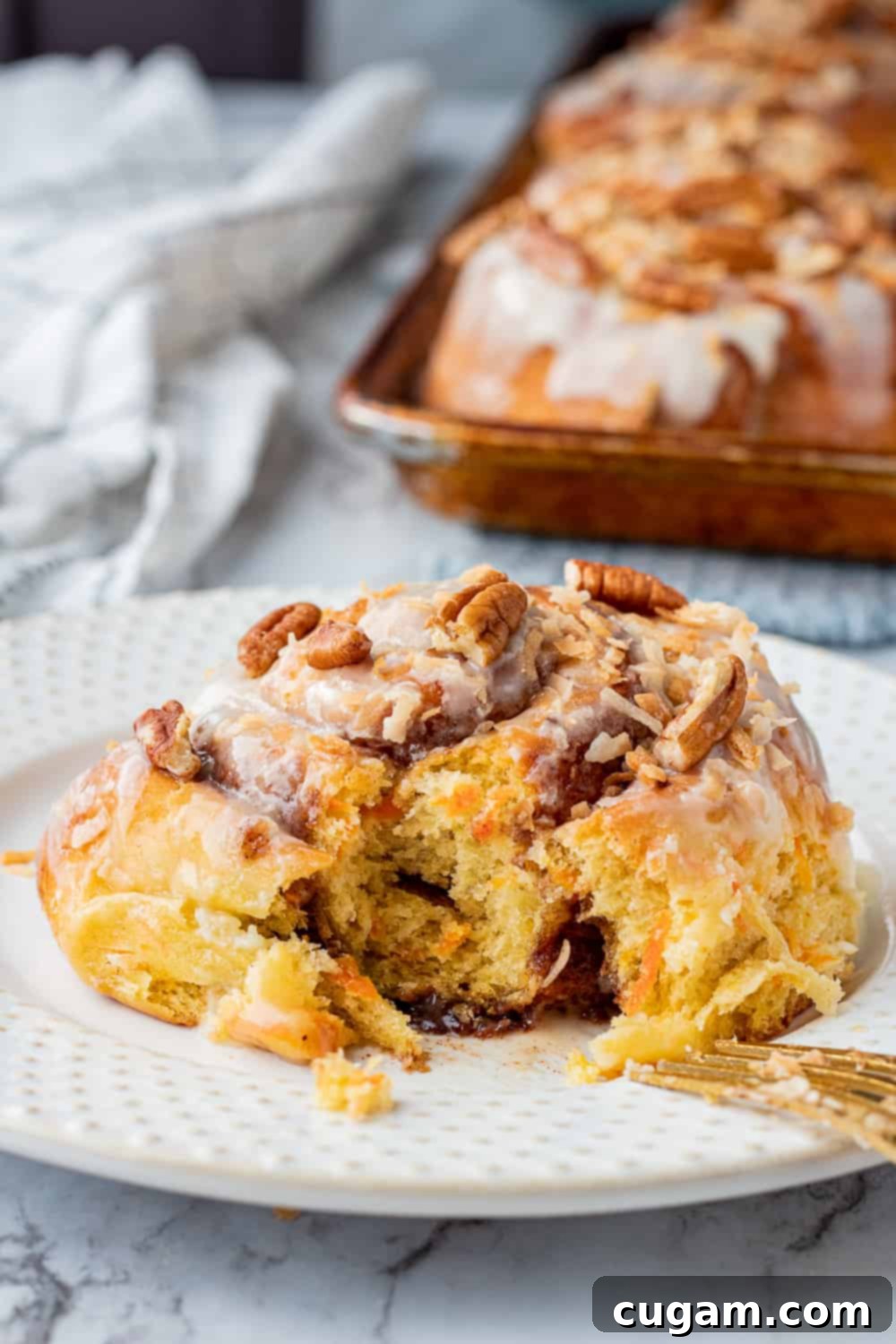
📝 Printable Recipe
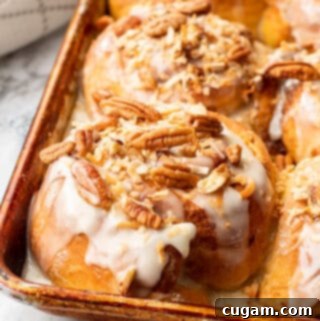
Carrot Cake Cinnamon Rolls
Pin Recipe
Equipment
-
Rolling Pin
-
Mixing Bowl
-
Baking Sheet/baking pan
Ingredients
For the dough:
- 1 cup milk (warm, approx 100-119F)
- ¼ cup white granulated sugar
- 1 Tablespoon active dry yeast
- 1 teaspoon salt
- ¼ cup butter, softened (4 Tablespoons)
- 2 cups grated carrot (200g)
- 1 large egg
- 5-½ cups all-purpose flour (785g)
For the filling:
- 1 cup brown sugar
- 1 Tablespoon cinnamon
- ½ teaspoon ground ginger
- ¼ teaspoon ground clove
- ¼ teaspoon ground nutmeg
- ½ cup butter, softened
- 4-5 Tablespoons all purpose flour
For the icing
- 4 oz. cream cheese, softened
- ¼ cup butter (4 Tablespoons) softened
- 2 cups powdered sugar
- 1 teaspoon vanilla
- 2-3 Tablespoons whole milk or heavy cream
- ½ cup chopped pecans
- ½ cup toasted coconut
Instructions
For the dough:
-
In a small bowl combine warm milk (between 100-110 F), sugar, and active dry yeast and let sit 5 minutes or until foamy. If using instant yeast, simply combine all dough ingredients. Just keep the yeast away from direct contact with the salt when combining ingredients (salt slows yeast growth).
-
In a stand mixer with dough hook attachment (or large bowl if mixing by hand) combine salt, butter, grated carrot, egg, and 5 cups of flour. Pour foamy yeast mixture in and mix with dough hook on low speed for 5-8 minutes until smooth and elastic (if mixing without a mixer, simply mix with a wooden spoon until you can’t mix anymore and then begin kneading by hand 6-8 minutes.
Add another ½ cup (up to one cup if needed) of flour to make dough consistency thick and slightly sticky.
-
Oil a large bowl, place dough in it and cover with plastic wrap. Let rise at room temperature for one hour or until doubled in size.
For the filling:
-
In a medium bowl combine brown sugar, and spices (cinnamon, ginger, clove, and nutmeg). Set aside.
-
On a floured work surface with rolling pin, roll dough into roughly a 24 inch by 12-14 inch rectangle. I stop occasionally and shape it with my hands to keep a rectangular shape.
-
Spread softened butter over dough with a spoon or pastry brush.
Sprinkle and spread sugar mixture evenly over butter.
Sprinkle 4-5 Tablespoons of flour evenly over filling (a sifter works great if you have one). Carefully roll dough lengthwise into a long roll. Mark the dough into 12 equal portions with a knife.
-
Use a piece of clean string or dental floss and slide the string underneath the roll. Pick up both ends of the string, cross them, and pull tight to cut the dough into 12 equal pieces. Place rolls cut side down into an oiled 9×13 inch pan or large baking sheet, being careful not to crowd the rolls so they have room to rise.
-
Cover with a dish towel, and let rise for 45 minutes to one hour until almost doubled in size. Preheat oven to 350 F. Bake for 25-30 minutes, until light golden brown on top. (Glass pans take more time, dark pans & large baking sheets take less time.) Cool 15-20 minute before icing.
For the icing:
-
In a medium bowl combine cream cheese, butter and mix until most of the lumps are gone. You can microwave them for 10-20 seconds to soften them enough to mix. Mix in powdered sugar, vanilla, and milk until smooth. I like my icing thicker like frosting. Add another 1-2 Tablespoons milk if you prefer a thinner glaze. Generously spoon icing over rolls to coat evenly, and top with pecans and toasted coconut.
Serve warm for maximum deliciousness.
Notes
- Follow recipe to make dough, fill, roll, and cut dough into 12 equal rolls and place cut side down onto a baking sheet or 9×13 inch pan.
- Cover with plastic wrap. Do not let rise first or they will deflate in the refrigerator. Cooling the dough simply slows yeast growth, it does not kill it.
- Place in fridge overnight.
- Remove from refrigerator and let rise for 30-40 minutes in warm place before baking. I like to turn on the oven to 200 F for 2 minutes, then turn off the oven and set the rolls inside to rise with the door cracked open.
- Bake at 350 F for 32-35 min (or 25 min if on a large baking sheet). Glass pans will take a few more minutes to bake than dark pans.
Freezer instructions:
- Follow directions to make dough, fill, roll, and cut dough into rolls and place into foil lined pan so edges are not touching, and cover with plastic wrap. Place in the freezer immediately, do not let rise first or they will deflate in the freezer. Once frozen, transfer to freezer bag or airtight freezer safe container.
- Freeze until ready to use up to 3 months. Do NOT microwave dough to thaw. It will kill the yeast.
- Regular rise method: Remove from freezer, thaw in warm place (covered) for 3-5 hours or until almost doubled in size.
- Quicker rise method: Turn ON oven to 200 degrees for 2 minutes then turn OFF oven. Place rolls in oven and let thaw and rise 2-3 hours until almost doubled in size.
- Bake at 350 F for 25 minutes (if on large baking sheet) and 32-35 min (if in 19x13in pan). Glass pans will take a few more minutes to bake than dark pans.
